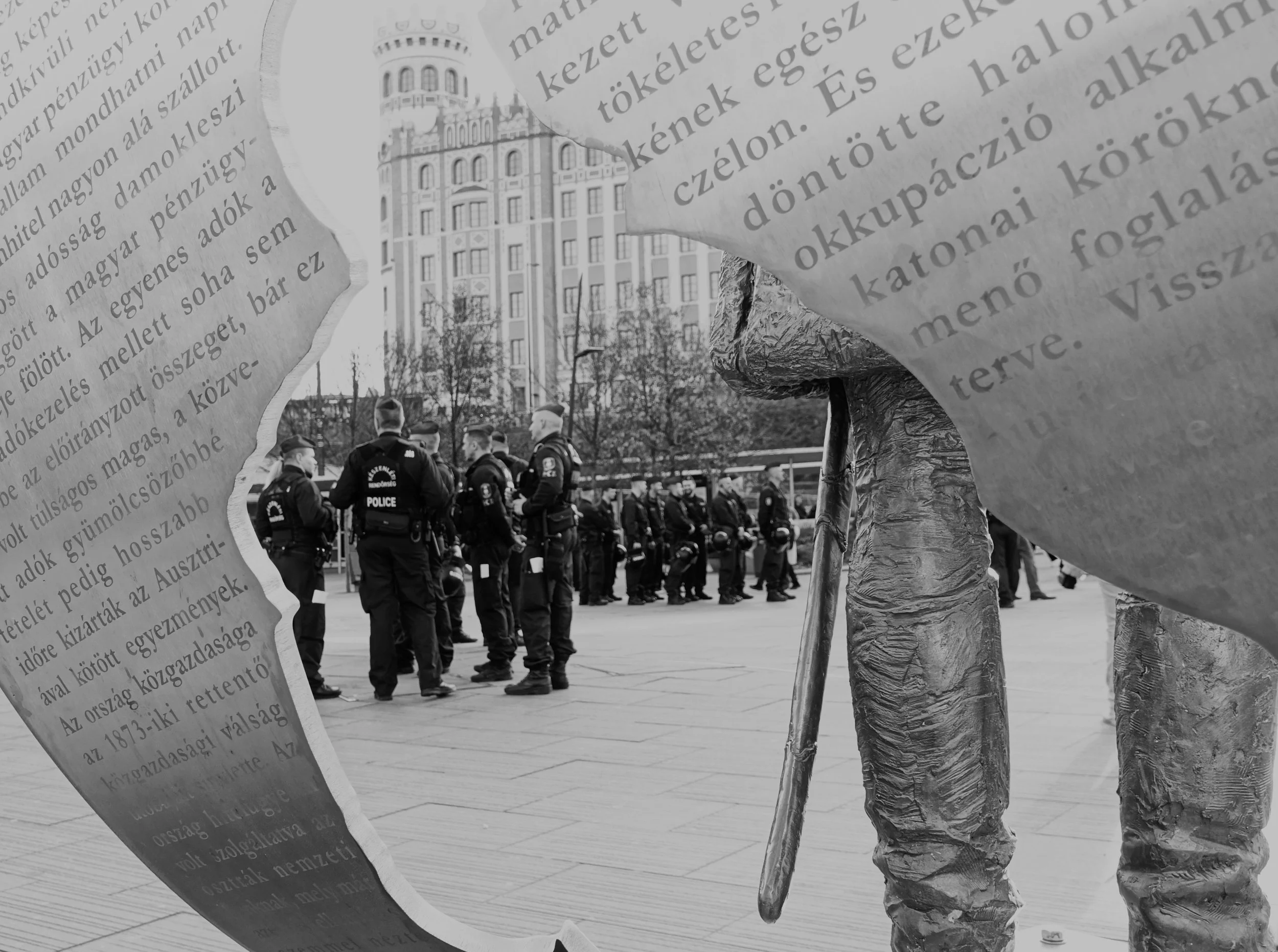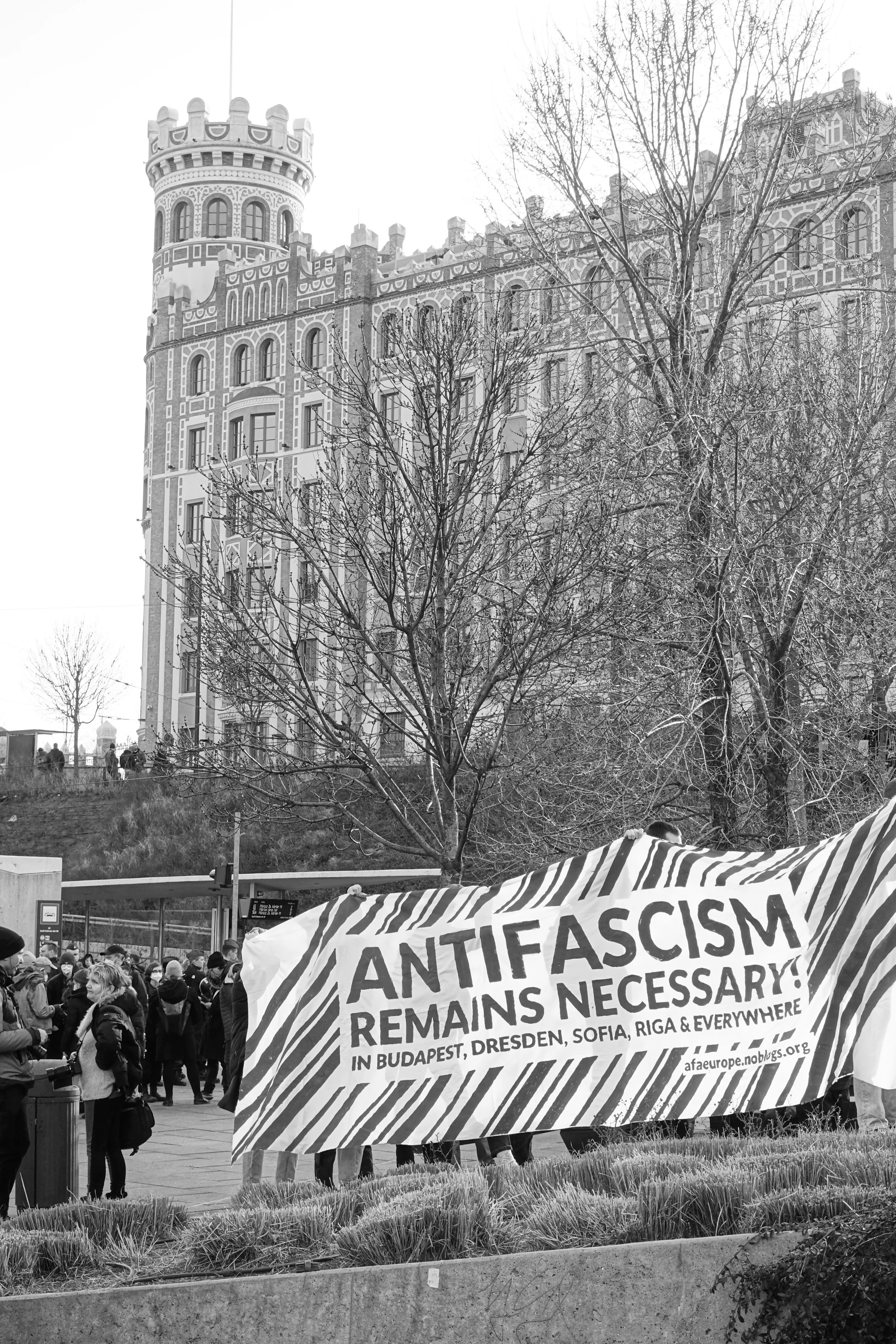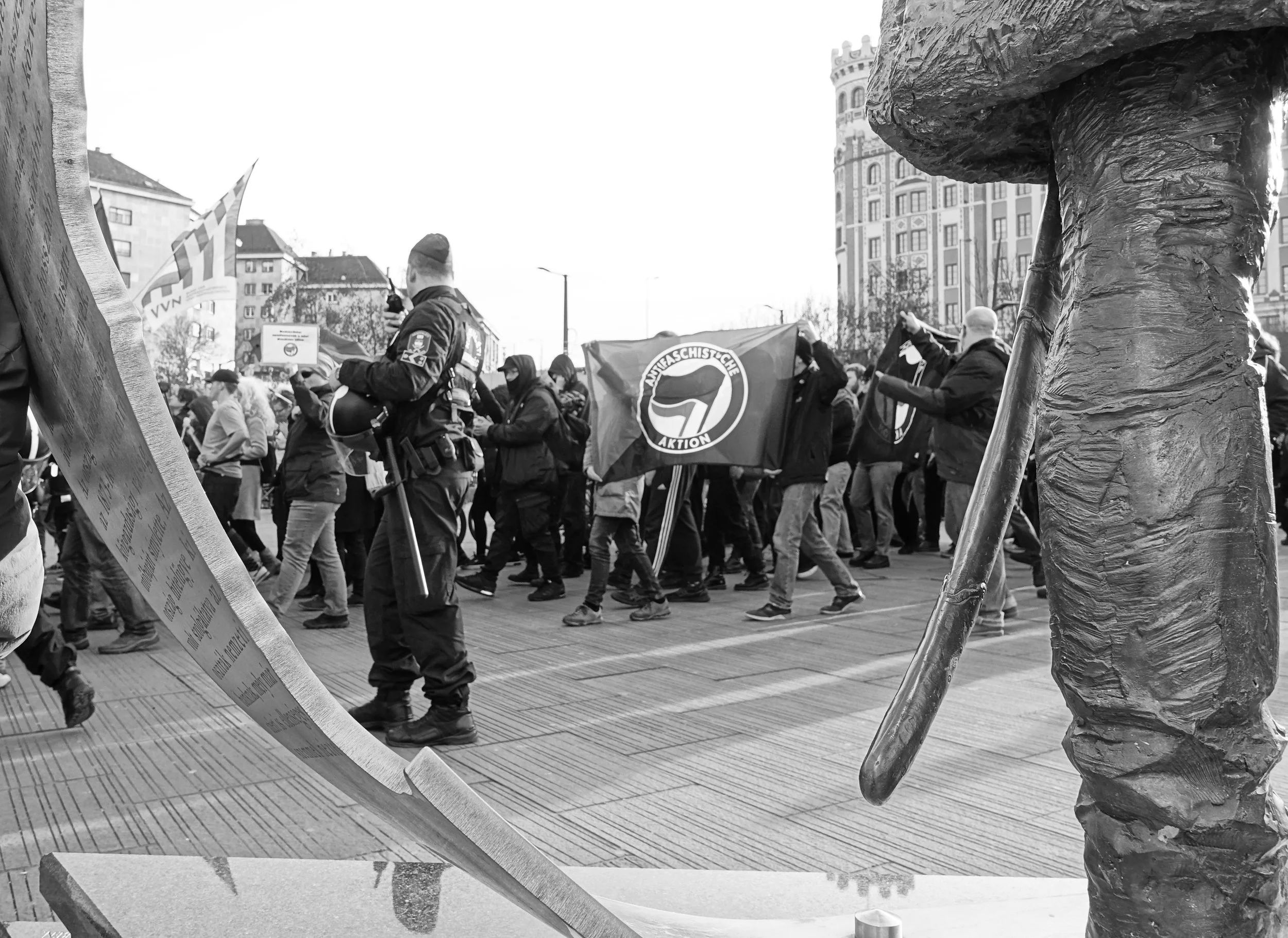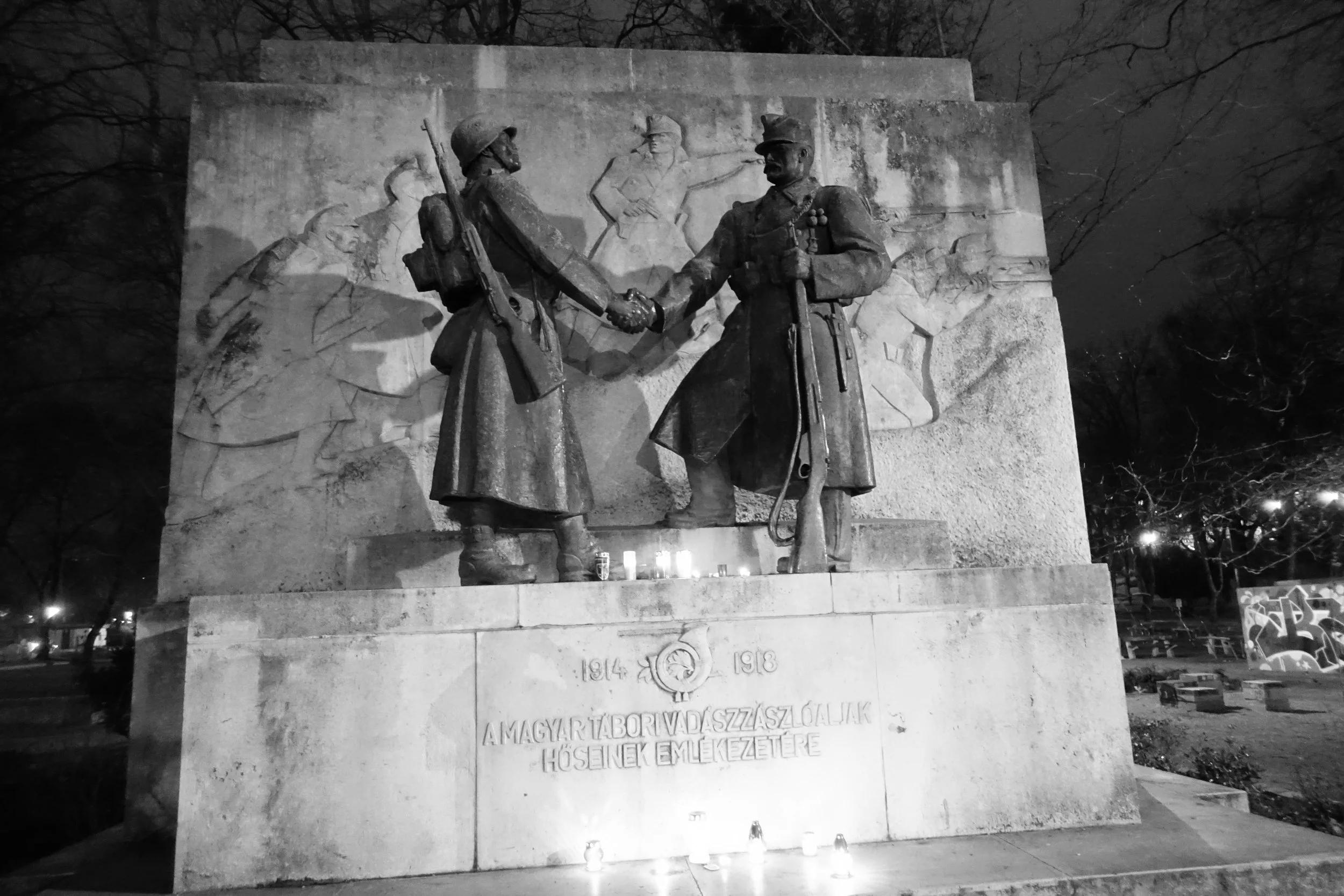Has Hungary broken away from its angry past?
Police waiting for potential conflict between left and right wing demonstrators in Széll Kálmán tér
Evidence is visible throughout Budapest of a tumultuous twentieth century when extreme politics devastated the country. Brass plaques set in the pavement, recall victims of the Holocaust. Bullet holes from the failed revolution of 1956 remain visible in unplastered buildings. Less well known, the Hungarian and German Breakout from Buda Castle in February 1945 remains a contentious and contested event. It is celebrated each year as the ‘Day of Honour’ by the far-right while being seen as a disgraceful episode by leftists, in which thousands of innocent civilians and soldiers died unnecessarily. Nowadays it is of minority interest in Hungary and after so long, many people probably want to forget all about it. The 2023 ‘Day of Honour’ saw a trail of blood left around this usually peaceful city, when mostly foreign-national ‘Antifa’ attacked random members of the public, bringing this memory once again to wider attention.
Antifascist demonstrators make their point.
I was curious as to how this year’s events would pass and visited near-to-home Széll Kálmán tér, a lively transport hub in Buda located in the shadow of the Castle district. It was the centre of much fighting during those tragic night-time hours before the Soviet army finally conquered the city after one of the longest and bloodiest sieges of WW2. The square has remained a potential flashpoint on the 11th of February each year, the anniversary of when forty-four thousand Hungarian and German soldiers ‘broke out’ of the Castle, accompanied by between 10-20,000 civilians. It is regarded as a military failure and civilian disaster by most historians. Exact numbers of civilian losses from this event are uncertain, although 38,000 died over the hundred days of the entire siege*. Only seven hundred German troops made a successful escape to join up with a larger force north of the capital. Most of the Hungarian soldiers who escaped the Castle, died in the streets around Széll Kálmán tér.
Seventy-nine years later, the usual flower sellers, buskers and beggars had been displaced by a gathering of a hundred Hungarian and other European Antifascist demonstrators. Some were masked and carried the usual banners and paraphernalia of protest. Since the pandemic, masks are no longer such a symbol of secrecy and the wearers didn’t appear threatening. Watched by as many police officers and members of the media, the leftist gathering awaited the far-right to mount a counter-demonstration. Passers-by continued their usual Saturday programmes, seemingly unaware or unconcerned by events on this mild afternoon.
The Breakout in 1945 took place during a savagely cold winter when snow and ice coated the besieged city for months. This year’s commemoration saw temperatures reach 17 degrees Celsius in the capital. A false spring probably but it created a sense that modern Hungary has departed from the extremism of the twentieth century, that Budapest is a different city with a different climate from one which experienced the horrors of totalitarianism in its varied forms.
Not everyone would agree with this conclusion and some cannot forget mistakes made during war time. The Hungarian left argue that the countries Regent, Miklós Horthy, had already withdrawn Hungary from the war and the troops in the Castle should have surrendered. Civilian lives in general would have been saved and Jewish ones in particular, as the Nazi Arrow Cross Party continued their genocidal policy until almost the end of the fighting. Although there are a number of examples where local troop units did change sides during the hundred-day long siege, many remained loyal to the Axis cause. Krisztián Ungváry, offering a balanced perspective in his excellent ‘Battle for Budapest’ book considers that the German leadership could have defied Hitler and broke out earlier. By the 11th of February he considers the odds were completely stacked against a successful escape.
In reply, the right argues that the subsequent abuse of Hungarian citizens, including mass deportation to Siberian workcamps, and widescale rape of women across the capital, not to forget the country’s subsequent occupation for forty-five years, is evidence that the Hungarian military remaining in the castle simply fought loyally in the protection of their homeland. Ungváry’s well researched book reveals the complexity and confusion of warfare. Hungary was caught up in a ruthless power struggle. Hitler had ordered the German army to fight to the last man in Budapest so that the Soviet advance to his beloved Vienna could be delayed as long as possible. Stalin ordered his generals to capture the Hungarian capital at any cost. Soviet forces also saw terrible casualties as a result of the siege (272 000 injured or dead*) including substantial Romanian and Ukrainian, as well as Russian troops. Despite clear military advantages, it still took them three months to secure the city.
European extremists of left and right visit Budapest each February to fan the flames of the past. Last year a group of ‘Antifa’ from Germany and Italy allegedly engaged in vicious attacks on innocent people, whose offence was to wear leather bomber jackets or camouflage style clothes. These attacks were carried out at a wide range of points mostly away from the Castle district. Some German participants have already pleaded guilty and the case of Ilaria Salis has attracted European wide coverage, when she was brought to court in chains after waiting almost a year to stand trial. Italian government protests at her treatment in a Hungarian prison cell have led to recent BBC and Guardian articles. Leaders of the ruling Fidesz party point to her dangerous record and on the official government English language pages, there are frightening images of the injuries sustained by the apparently innocent victims. The trial of Salis will no doubt continue to attract wider coverage and ahead of the forthcoming European Parliament elections, become further weaponised within political debate.
During the afternoon’s gathering in 2024, the different antifascist groups present, unified in the centre of the square. At one point a drum started up but there was no sign of the opposition to rant against. Unlike previous years, the far-right failed to put in an appearance and by late afternoon the leftist demonstrators marched off chanting peacefully. Apparently, the Hungarian and European far-right held music concerts at undisclosed venues near the capital, seemingly without trouble occurring. The day’s tension dissipated without a repeat of last year’s violence.
Antifascists peacefully leaving the square
After dark, I witnessed a strange activity associated with the ‘Day of Honour’. Over previous decades the Breakout has also become remembered in the form of a walking ‘ tour’, whereby politically motivated along with energetic sporty types, hike from the castle into the Buda Hills replicating the route taken by the few who were successful in escaping from the siege. Some hikers travel by night attempting to authenticate the experience of 1945. Although wearing fascistic and communist symbols has long been illegal in Hungary, some participants in previous years wore Nazi and Arrow Cross clothing at commemoration events held enroute. In 2022 these events were also banned, but the ‘tour’ continues.
At six pm, I watch two police officers patrol Szamos utca. This route cuts across Varosmajor Park and was one of three lines of defence here, held by Hungarian forces for much of January in the winter of 1945, before the superior numbers and weaponry of the Soviet army crushed their resistance and enabled the climax of the siege at the castle. There are still large stones from the defences and remains of a battered concrete machine gun emplacement to be found in the park.
Last Saturday evening I observed three small groups and one individual hiker make his away across Városmajor. They were in their twenties and thirties and wore modern hiking clothes and rucksacks. None were in military uniforms. The temperature was still over fifteen degrees and the solo walker stopped to drink from his bottle. Their destination somewhere beyond Remete-hegy (Hermits Hill) was a less than straightforward walk in the dark. But a much safer one than that undertook by the fleeing soldiers and civilians in 1945.
By February of that year, Adolf Eichmann and the leading members of the evil Arrow Cross party had already departed Hungary. The latter mostly captured later in Austria. The former, and prime organiser of the Holocaust, moved around Germany for several years before hiding in Argentina until captured by Mossad and brought to trial in Tel Aviv. Eichmann’s activities in Hungary, particularly by ordering further ‘death marches’ after Himmler had told him to stop, provided the most solid evidence against him at his trial. He was executed in Israel in 1962.
Significant to the Breakout was that the German and Hungarian Chiefs of Staff remaining, probably aware of its likely suicidal outcome, chose not to rush down from the Castle and storm the Soviet barricades. Instead, they attempted a subterranean escape through the culverted Ördög-árok (Devil’s Ditch). All were captured and the Hungarian Commander in Chief, Ivan Hindy, was executed by the Soviets, being found guilty of ignoring Horthy’s truce and responsible for subsequent war crimes.
Last Saturday, tea lights and candles illuminated the first world war memorial in the centre of Városmajor park. Lit by Breakout walkers—probably in recognition of the Trianon settlement of 1920, when Hungary lost two-thirds of its pre-war territory and almost sixty percent of its population, there isn’t the space here to delve into the consequences of that loss but it is vital to understand it, in terms of Hungary’s role during the second world war and even in the politics of today. Its memory could be compared with the battle of the Boyne in 1690, forgotten by most British people, but still remembered by Republicans and Loyalists alike in Northern Ireland. Like Ulster, time is proving a great healer among younger generations and although Trianon is a key part of the school history curriculum, those taking up the extremist cause in Hungary are few in number.
Városmajor park, early evening on the 11th February 2024
If attendance at events based around the ‘Day of Honour’ is a measure, then most Hungarians have already made an important break with the past. Some facts about the final days of the siege in Budapest are clear—others open to endless interpretation. Truth is the first casualty of war, while the process of history only offers a belated post-mortem; rarely a prescription for future political ailments. Of former times, we often believe what we want to believe. It’s easy to say this, a difficult failing to recognise in oneself. And a common problem, not just one the Hungarians face when it comes down to understanding the mishmash of our yesterdays.
*The Battle for Budapest- Krisztián Ungváry,



